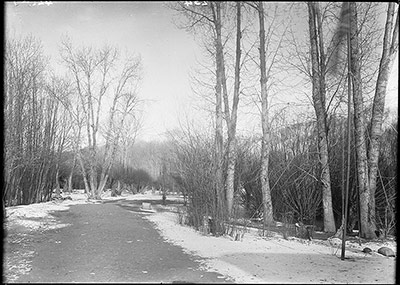
1998.285.259 (Glass negative)


1998.285.259 (Glass negative)

Rabden Lepcha?
Sir Charles Bell
March 1921
Lhasa > Kundeling
1998.285.259
120 x 163 mm
Negative glass plate gelatin
Donated 1983
St Antony's College, Oxford.
Sir Charles Bell's Mission to Lhasa 1920-21
Royal Central Asiatic Society
BL.H.234
Manual Catalogues - Bell's List of Illustrations entry: "[No. of chapter] XLIII. [Subject of Chapter] The Flora [Subject of Illustration] H. 234 (d) Poplars and willows in our lingka at Kundeling, Lhasa. Ground under snow , March 1921."
Other Information - Cultural background: Bell's Diary entry for 9th June:"There are two kinds of poplar trees in Lhasa; one like the kind at Gyantse; the other different to any poplar in Gyantse, the Chumbi Valley or Sikkim. The wood of the second kind somewhat resembles that of the poplar in Sikkim and the Chumbi Valley but the leaves are smaller and shaped more like the leaves of a maple. This kind is called "White Poplar" ( ja - kar ) [Tibetan script] in Lhasa. // It is used for house pillars, though soft, because it is easily carved with the designs appropriate to such pillars. Neto Jongpen thinks it is indigenous to Tibet, for he says the wood is rather poor and it would not have been worthwhile to introduce it from China or elsewhere. I do not remember to have seen it anywhere in India." [Diary Vol. XI., p.1]
Other Information - Cultural Background: Bell's diary for 29th July 1921:" Lhack-cho orderly, one of my Tibetan orderlies, calls the weeping willow "Sorrow Tree" ( Nyan-gen shing ). Many of the people believe that when the 5th D[alai] L[ama] died, the branches of the weeping willows bent down and have bent down ever since. Formerly they stood up." [Diary Vol. XI, p.64]
Other Information - Background: Richardson mentions this site in High Peaks, Pure Earth , London, Serindia Publications, 1998, p. 303. "The monastery of Kun-bde-gling (1936-9, 1944, 1946-50) was built by the Chinese in 1794 for their protege,the Regent Rta-tshag Ye-shes mgon-po, in celebration of their victory over the Gurkhas. It was very generously endowed. A stone stele recording the foundation, inscribed in Tibetan and Chinese, stood at the entrance of the monastery. Further north on a rocky hillock known as Ba-ma-ri (or Ba-mo-ri) stood a little temple of the Chinese war god Kuanti, known to the Tibetans as Ge-sar. ... The Ge-sar Lha-khang was popular with Tibetan pilgrims for the reading of fortunes from bamboo slips chosen at random from a tall vase." [KC 13/10/2006]
For Citation use:
The Tibet Album.
"Lingka at Kundeling, Lhasa"
05 Dec. 2006. The Pitt Rivers Museum.
<http://tibet.prm.ox.ac.uk/photo_1998.285.259.html>.
For more information about photographic usage or to order prints, please visit the The Pitt Rivers Museum.
© The Pitt Rivers Museum